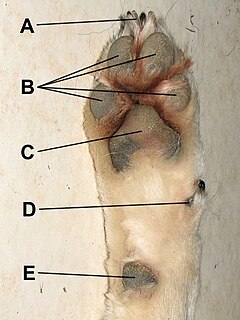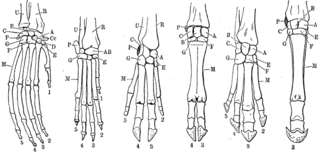 W
WAcute limb ischaemia (ALI) occurs when there is a sudden lack of blood flow to a limb.
 W
WBird wings are a paired forelimb in birds. The wings give the birds the ability to fly, creating lift.
 W
WA dewclaw is a digit – vestigial in some animals – on the foot of many mammals, birds, and reptiles. It commonly grows higher on the leg than the rest of the foot, such that in digitigrade or unguligrade species it does not make contact with the ground when the animal is standing. The name refers to the dewclaw's alleged tendency to brush dew away from the grass. On dogs and cats the dewclaws are on the inside of the front legs, similarly to a human's thumb, which shares evolutionary homology. Although many animals have dewclaws, other similar species do not, such as horses, giraffes and the African wild dog.
 W
WA digit is one of several most distal parts of a limb, such as fingers or toes, present in many vertebrates.
 W
WA fascial compartment is a section within the body that contains muscles and nerves and is surrounded by fascia. In the human body, the limbs can each be divided into two segments – the upper limb can be divided into the arm and the forearm and the sectional compartments of both of these – the fascial compartments of the arm and the fascial compartments of the forearm contain an anterior and a posterior compartment. Likewise, the lower limbs can be divided into two segments – the leg and the thigh – and these contain the fascial compartments of the leg and the fascial compartments of the thigh.
 W
WA forelimb or front limb is one of the paired articulated appendages (limbs) attached on the cranial (anterior) end of a terrestrial tetrapod vertebrate's torso. With reference to quadrupeds, the term foreleg or front leg is often used instead. In bipedal animals with an upright posture, the term upper limb is often used.
 W
WPolydactyly in stem-tetrapods should here be understood as having more than five digits to the finger or foot, a condition that was the natural state of affairs in the very first stegocephalians during the evolution of terrestriality. The polydactyly in these largely aquatic animals is not to be confused with polydactyly in the medical sense, i.e. it was not an anomaly in the sense it was not a congenital condition of having more than the typical number of digits for a given taxon. Rather, it appears to be a result of the early evolution from a limb with a fin rather than digits.
 W
WThe upper limbs or upper extremities are the forelimbs of an upright-postured tetrapod vertebrate, extending from the scapulae and clavicles down to and including the digits, including all the musculatures and ligaments involved with the shoulder, elbow, wrist and knuckle joints. In humans, each upper limb is divided into the arm, forearm and hand, and is primarily used for climbing, lifting and manipulating objects.